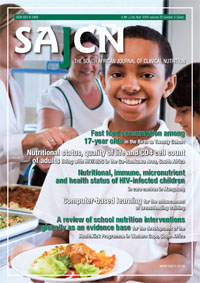Nutritional, immune, micronutrient and health status of HIV-infected children in care centres in Mangaung
Keywords:
HIV, Nutrition, Immune, Health, AIDS orphans
Abstract
Aim: To assess the nutritional, immune, micronutrient and health status of antiretroviral naïve HIV-infected children in selected care centres in Mangaung, in the Free State. Method: A cross-sectional descriptive study was undertaken between September 2004 and March 2005 on antiretroviral naïve HIV-infected children in care centres in Mangaung. Results: The study included 37 clinically stable and food secure HIV-infected children. Their median age was 5.35 years (ranging from 1.16 years to 10.17 years). Fifteen children (46%) were underweight, 30 children (77%) were stunted and one child was wasted. The median viral load (n=35) of the group was 117 000 copies/ml, the median CD4+ cell count was 477 cells/mm3 and the median CD4 percentage was 22.5%. Deficient serum levels relative to normal reference values were recorded for glutathione in 91%, albumin in 78%, vitamin A in 63%, vitamin D in 44%, zinc in 38% and vitamin E in 13% of the children. Sixty percent of the children were anaemic and 30% were iron deficient. The most commonly occurring clinical features were lymphadenopathy in 84%, skin rashes in 51%, hepatomegaly in 32%, pallor in 41%, clubbing in 24%, ear infections in 24%, oedema in 22% and mucosal lesions in 16%. Only 8% presented with TB, while 19% had features of lower respiratory infection. Conclusion: A high prevalence of chronic malnutrition and micronutrient deficiencies occurred among HIV-infected children residing in food secure care centres. The study highlights the importance of antiretroviral therapy and nutrition intervention in improving the management and prognosis of these children.
Published
2009-07-26
How to Cite
Steenkamp, L., Dannhauser, A., Walsh, D., Joubert, G., Veldman, F., van der Walt, E., Cox, C., Hendricks, M., & Dippenaar, H. (2009). Nutritional, immune, micronutrient and health status of HIV-infected children in care centres in Mangaung. South African Journal of Clinical Nutrition, 22(3), 131. Retrieved from http://sajcn.co.za/index.php/SAJCN/article/view/245
Issue
Section
Original Research
Material submitted for publication in the South African Journal of Clinical Nutrition (SAJCN) is accepted provided it has not been published elsewhere. Copyright forms will be sent with acknowledgement of receipt and the SAJCN reserves copyright of the material published.
The SAJCN does not hold itself responsible for statements made by the authors.


